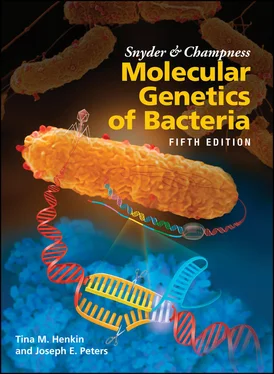Some exceptions to the code occur only at specific sites in the mRNA. For example, UGA encodes the rare amino acid selenocysteine in some contexts. This amino acid exists at one or a very few positions in certain bacterial and eukaryotic proteins. It has its own unique aaRS, translation elongation factor (analogous to EF-Tu), and tRNA, to which the amino acid serine is added and then converted into selenocysteine. This tRNA then inserts the amino acid selenocysteine at certain UGA codons, but only at a very few unique positions in proteins and not every time a UGA appears in frame. How, then, does the tRNA distinguish between these sites and the numerous other UGAs, which usually signify the end of a polypeptide? The answer seems to be that the selenocysteine-specific EF-Tu has extra sequences that recognize the mRNA sequences around the selenocysteine-specific UGA codon, and only if the UGA codon is flanked by these particular sequences will this EF-Tu allow its tRNA to enter the ribosome. It is a mystery why the cell goes to so much trouble to insert selenocysteine in a specific site in only a very few proteins. In some instances where selenocysteine was replaced by cysteine, the mutated protein still functioned, albeit less efficiently. However, it may be required in the active center of some enzymes involved in anaerobic metabolism, and this amino acid has persisted throughout evolution, existing in organisms from bacteria to humans.
Another striking deviation from the code is found in the methanogenic archaea (archaea that produce methane). These bacteria insert the lysine analog pyrrolysine at the normal termination codon UAG. Unlike selenocysteine, which is chemically derived from serine already on its tRNA, pyrrolysine is synthesized and then loaded onto a dedicated tRNA by a dedicated aaRS. It therefore qualifies as the 22nd amino acid. Its aa-tRNA uses the normal EF-Tu and is inserted whenever the codon UAG appears within the mRNA.
Recently, efforts have been made to purposely reprogram the genetic code to allow targeted insertion of nonnatural amino acids into specific sites of individual target proteins with the goal of generating new classes of proteins with novel activities. This work relies on engineering systems to attach a new type of amino acid to a dedicated tRNA so that the tRNA will insert its amino acid only at a specific codon within the target protein. Approaches of this type will enable both specific labeling of proteins in the cell and development of new enzymatic activities.
Other exceptions violate the rule that the code is read three bases at a time until a termination codon is encountered. This happens with high-level frameshifting and readthrough of termination codons. In high-level frameshifting, the ribosome can back up one base or go forward one base before continuing translation. High-level frameshifting usually occurs where there are two cognate codons next to each other in the RNA, for example, in the sequence UUUUC, where both UUU and UUC are phenylalanine codons that are presumably recognized by the same tRNA through wobble. The ribosome with the tRNA bound can slip forward or backward by one nucleotide before it continues translating in the new reading frame, creating a frameshift. Sites at which high-level frameshifting occurs are designated “shifty sequences” and usually have common features. They often have a secondary structure, such as a pseudoknot, in the RNA (see Figure 2.2) just downstream of the frameshifted region, which causes the ribosome to pause. They also may have a sequence similar to an S-D sequence just upstream of the frameshifted site to which the ribosome then binds through its 16S rRNA, shifting the ribosome 1 nucleotide on the mRNA and causing the frameshift. Sometimes both the normal protein and the frameshifted protein, which has a different carboxyl end, can function in the cell. Examples are the E. coli DNA polymerase accessory proteins γ and τ, which are both products of the dnaX gene (see Table 1.1) but differ because of a frameshift that results in the formation of a truncated protein. Frameshifting can also allow the readthrough of termination codons to make “polyproteins,” as occurs in many retroviruses, such as human immunodeficiency virus (the acquired immune deficiency syndrome [AIDS] virus). Moreover, high-level frameshifting can play a regulatory role, for example, in the regulation of the RF2 gene in E. coli . The RF2 protein causes release of the ribosome at the termination codons UGA and UAA (see “Translation Termination” in the text). The gene for RF2 in E. coli is arranged so that its function in translation termination can be used to regulate its own synthesis through frameshifting (see chapter 11). How long the ribosome pauses at a UGA codon depends on the amount of RF2 in the cell. If there is a lot of RF2 in the cell, the pause is brief and the polypeptide is quickly released by RF2. If there is less RF2, the ribosome will pause longer, allowing time for a –1 frameshift. The RF2 protein is translated in the –1 frame, so this is the correct frame for translation of RF2, and more RF2 will be made if there is not enough for rapid termination.
In the most dramatic cases of frameshifting, the ribosome can hop over large sequences in the mRNA and then continue translating. This is known to occur in gene 60 of bacteriophage T4 and the trpR gene of E. coli . Somehow, the ribosome stops translating the mRNA at a certain codon and “hops” to the same codon further along. Presumably, the secondary and tertiary structures of the mRNA between the two codons cause the ribosome to hop. In the case of gene 60 of T4, the hopping occurs almost 100% of the time, and the protein that results is the normal product of the gene. In the E. coli trpR gene, the hopping is less efficient, and the physiological significance of the hopped form is unknown.
High-level readthrough of termination codons can also give rise to more than one protein from the same ORF. Instead of stopping at a particular termination codon, the ribosome sometimes continues making a longer protein, in addition to the shorter one. Examples are the synthesis of the head proteins Qβ and the synthesis of Gag and Pol proteins in some retroviruses. Many plant vituses also make readthrough proteins. Again, it seems to be the sequence around the termination codon that promotes high-level readthrough. However, it is important to emphasize that these are all exceptions, and normally, the codons on an mRNA are translated faithfully one after the other from the TIR until a termination codon is encountered.
Baranov PV, Fayet O, Hendrix RW, Atkins JF. 2006. Recoding in bacteriophages and bacterial IS elements. Trends Genet 22:174–181.
Böck A, Forchhammer K, Heider J, Leinfelder W, Sawers G, Veprek B, Zinoni F.1991. Selenocysteine: the 21st amino acid. Mol Microbiol 5:51 5 –520.
Gaston MA, Jiang R, Krzycki JA.2011. Functional context, biosynthesis, and genetic encoding of pyrrolysine. Curr Opin Microbiol 14:342–349.
Maldonado R, Herr AJ.1998. Efficiency of T4 gene 60 translational bypassing. J Bacteriol 180:1822–1830.
Young TS, Schultz PG.2010. Beyond the canonical 20 amino acids: expanding the genetic lexicon. J Biol Chem 285:11039–11044.
Codons that encode the same amino acid often differ only by their third base, which is why they tend to be together in the same column when the code is presented as in Table 2.2. This pattern of redundancy in the code is due to less stringent pairing, or wobble, between the last (3′) base in the codon on the mRNA and the first (5′) base in the anticodon on the tRNA (remember that RNA sequences are always given 5′ to 3′ and that the pairing of strands of RNA, like that of DNA, is antiparallel [ Figure 2.25]). As a consequence of wobble, the same tRNA can pair with more than one of the codons for a particular amino acid, so there can be fewer types of tRNA than there are codons. For example, even though there are two codons for lysine, AAA and AAG, E. coli has only one tRNA for lysine, which, because of wobble, can pair with both lysine codons.
Читать дальше











